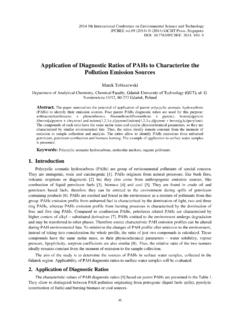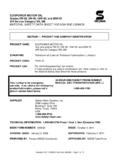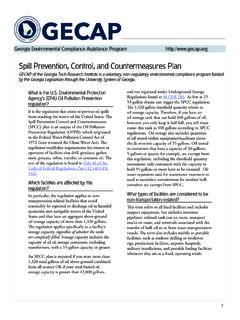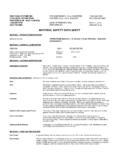Transcription of Material Safety Data Sheet MSDS Number: M1002 …
1 Material Safety data SheetKeroseneMSDS number : M1002 Effective Date: 8/12/2004 msds Name: KeroseneSynonyms: Kerosine, Coal Oil, Fuel Oil #1, Turbine FuelCompany Identification: VEE GEE Scientific, Inc. 13600 NE 126th Pl Ste A Kirkland, WA 98034 For information in North America, call: 425-823-4518 Composition, Information on IngredientsSection 2 -Chemical Product and Company IdentificationSection 1 -CAS#Chemical NamePercentEINECS/ELINCS8008-20-6 Kerosene90-100%232-366-4 Hazard Symbols: XNRisk Phrases: 65 Hazards IdentificationSection 3 -1. The major effect of exposure to this product is headache, drowsiness, irritation of the eyes and nose, and lungs. Target organs include the respira-tory system, nervous system, and mucous NIOSH recommends that whole diesel engine exhaust be regarded as a potential occupational carcinogen.
2 Follow OSHA and NSHA rules wherediesel engine exhaust fumes may be A life time skin painting study by the American Petroleum Institute has shown that similar naphtha products with a boiling range of 350-700 degrees Fusually produce skin tumors and/ or skin cancers in laboratory mice. Only a weak to moderate response occurred. The effect to humans has not beendetermined. Contact dermatitis (skin irritation) may occur with prolonged or repeated IARC has listed kerosene as probably carcinogenic to humans based on sufficient evidence in experimental animals and limited evidence of Combustion Products: Carbon monoxide and carbon dioxide can be found in the combustion products of this product and other forms ofhydrocarbon combustion.
3 Carbon monoxide in moderate concentrations can cause symptoms of headache, nausea, vomiting, increased cardiacoutput, and confusion. Exposure to higher concentrations of carbon monoxide can cause loss of consciousness, heart damage, brain damage, and/ordeath. Exposure to high concentrations of carbon dioxide can cause simple asphyxiation by displacing available oxygen. Combustion of this and othersimilar materials should only be carried out in well ventilated areas. The National Kerosene Heater Association has released preliminary test resultsthat indicate no increased emissions of carbon monoxide or nitrogen dioxide resulted from using red-dyed kerosene in "new generation" Condition Generally Aggravated By Exposure: Medical conditions which have the same symptoms and effects as those outlined under thehealth hazard information section can be aggraved by exposure to this Of ExposureInhalation: Irritation of the upper respiratory tract and eyes, with possible euphoria, dizziness, headache, discoordination, ringing in the ears, convul-sions, coma, and respiratory Contact.
4 Defatting of the skin may occur with continued and prolonged contact. Irritation and burning sensation may occur on exposure to theliquid or mists, as well as the possibility of blisters. Hair loss can occur upon chronic Absorption: Not Contact: Severe burning sensation with temporary irritation and swelling of : Irritation of the mucous membranes of throat, esophagus and stomach which may result in nausea and vomiting; central nervous systemdepression may occur, if absorbed (see inhalation symptoms above). If aspirated, chemical pneumonitis may occur with potentially fatal Statement: Kerosene is not listed as carcinogenic by NTP, OSHA, and ACGIH. IARC has listed kerosene as a probable humancarcinogen (2A).
5 M1002 Page 1/4 Effective Date: 8/12/2004 First Aid MeasuresSection 4 -Eyes: Immediately flush eyes with large amount of water for at least 15 minutes holding lids apart to ensure flushing of the entire eye surface. SEEKMEDICAL : Wash contaminated areas with plenty of soap and water. A soothing ointment may be applied to irritated skin after thoroughly cleansing. Removecontaminated clothing and footwear. SEEK MEDICAL : Get person out of contaminated area to fresh air. If breathing has stopped resuscitate and administer oxygen if readily available. SEEKMEDICAL ATTENTION : Never give anything by mouth to an unconscious person. If swallowed, do not induce vomiting.
6 If vomiting occurs spontaneously, keepairway clear. SEEK MEDICAL ATTENTION to Physician: Do not induce vomiting, use gastric lavage only. Aspiration of liquid into the lungs could result in chemical pneumonitis. Use ofadrenaline is not advised. Treat Release MeasuresSection 6 -Flash Point: 100 F PM (minimum)Autoignition Temperature: 410 FFlammable Limits In Air: UEL: 5% - LEL: Media: Use dry chemical, carbon dioxide, foam or water spray. Water may be ineffective in fighting fires of liquids with low flash points,but water should be used to keep fire exposed containers cool. If a leak or spill has not ignited, use water spray to disperse the vapors and to protectpersons attempting to stop a Fire Fighting Procedures: Pressure-demand, self contained, breathing apparatus should be provided for fire fighters in buildings or confinedareas where product is Fire And Explosion Hazard: Clothing, rags, or similar organic Material contaminated with the product and stored in a closed space mayundergo spontaneous combustion.
7 Vapor accumulation is possible and flashback can occur with explosive force if vapors are and StorageSection 7 - M1002 Page 2/4 Effective Date: 8/12/2004 Fire Fighting MeasuresSection 5 -If Material is spilled, steps should be taken to contain liquid and prevent discharges to streams or sewer systems and control or stop the loss of volatilematerials to the atmosphere. Spills or releases should be reported, if required to the appropriate local, state and federal regulatory Spills: Remove ignition sources. Absorb spilled Material with non-combustible materials such as cat litter, dirt, sand, or petroleum sorbent pads/pillows. Do not use combustible materials like rags, wood chips, or saw dust.
8 Remove contaminated materials to an appropriate disposal Spills: Remove ignition sources. Dike spill area with sand or dirt to contain Material and cover sewers/drains. Remain upwind and keepunnecessary people away. Contact trained emergency response team for cleanup. Remove liquid using grounded suction pumps, isolate hazard areaand deny only in approved containers. Protect containers against physical damage. Outside or detached storage is preferred. Separate from oxidizingmaterials. Store in cool, well ventilated area of non-combustible construction away from possible sources of ignition. Keep away from incompatiblematerials and follow OSHA 29 CFR and NFPA 30 for storage Use: This product is intended for use as a fuel in engines and heaters designed for kerosene or diesel fuels, and for use in engineeredprocesses.
9 Use in other applications may result in higher exposures and require additional controls, such as local exhaust ventilation and personalprotective Controls, Personal ProtectionSection 8 -Ventilation Requirements: Work in well ventilated areas using good engineering practices to process, transfer and store. Special ventilation in notrequired unless product is sprayed or heated. High volume use may require engineering Personal Protective EquipmentRespiratory: Respiratory protection is not required unless product is sprayed or heated. Use NIOSH approved respiratory protection followingmanufacture's recommendations where spray, mists, or vapors may be generated.
10 Supplied air respiratory protection is required for IDLH areas. See29 CFR for OSHA Respirator Protection : Face shield and goggles or chemical goggles should be worn where mist or spray may be generated, and where splashing occurs. Shower andeyewash facilities should be : Impermeable protective gloves such as nitrile gloves should be worn during routine handling of this product. Barrier creams may also beappropriate where tactile sensitivity is Clothing and Equipment: Clothing contaminated with this product should be removed and laundered before reuse. Items which can not belaundered should be discarded. Allow contaminated items to air dry or hang in a well ventilated area.






